Professionalism and Ethics in Nursing Practice: A Case Study Analysis
VerifiedAdded on 2023/03/17
|10
|2928
|36
AI Summary
This essay analyzes a case study to demonstrate the understanding of professionalism and ethics in nursing practice. It identifies transgressions that violate nursing standards and codes of conduct, discusses legal and ethical implications, and recommends actions to avoid misconduct.
Contribute Materials
Your contribution can guide someone’s learning journey. Share your
documents today.

Running head: NURSING
Nursing
Name of the student:
Name of the University:
Author’s note
Nursing
Name of the student:
Name of the University:
Author’s note
Secure Best Marks with AI Grader
Need help grading? Try our AI Grader for instant feedback on your assignments.
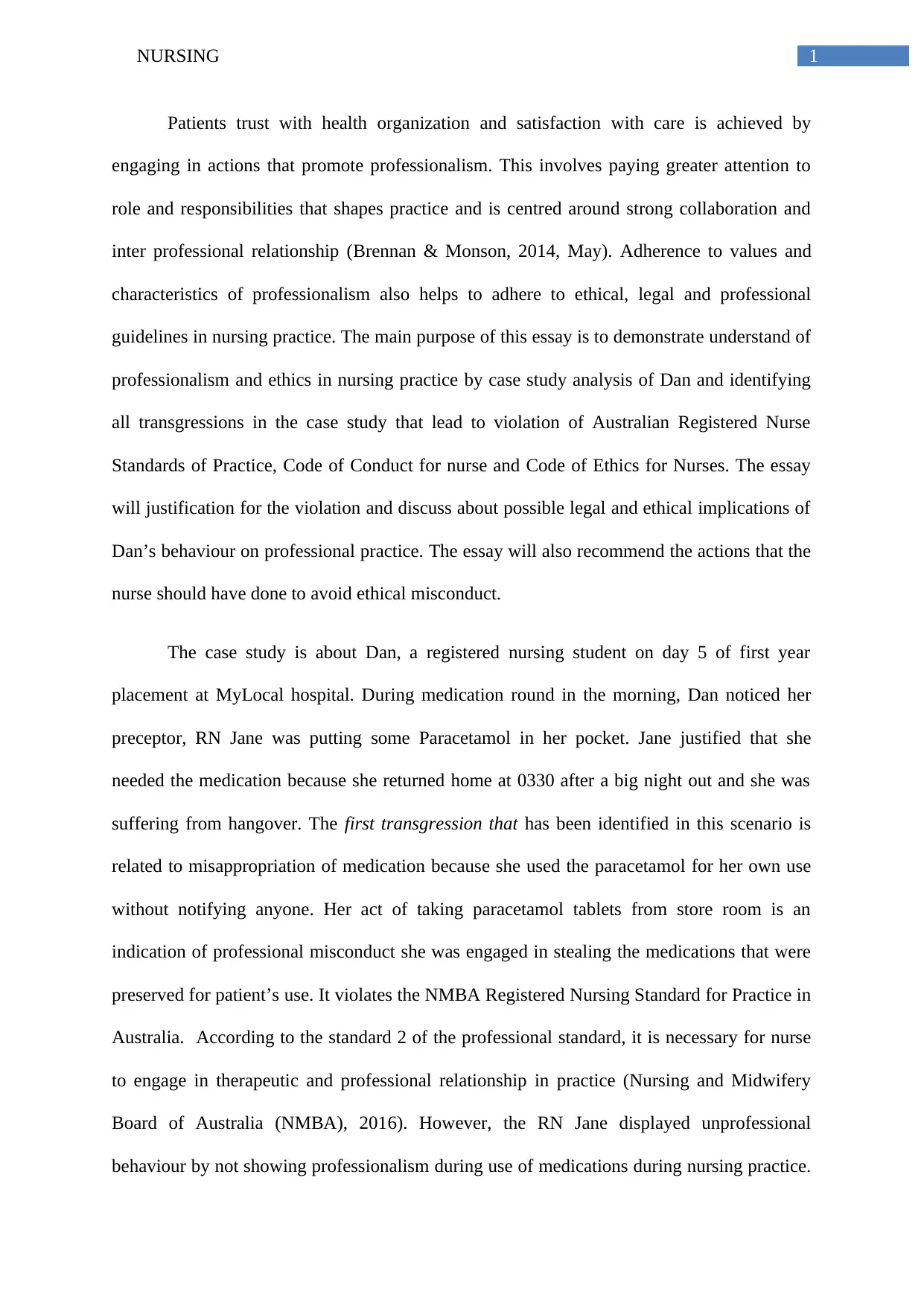
1NURSING
Patients trust with health organization and satisfaction with care is achieved by
engaging in actions that promote professionalism. This involves paying greater attention to
role and responsibilities that shapes practice and is centred around strong collaboration and
inter professional relationship (Brennan & Monson, 2014, May). Adherence to values and
characteristics of professionalism also helps to adhere to ethical, legal and professional
guidelines in nursing practice. The main purpose of this essay is to demonstrate understand of
professionalism and ethics in nursing practice by case study analysis of Dan and identifying
all transgressions in the case study that lead to violation of Australian Registered Nurse
Standards of Practice, Code of Conduct for nurse and Code of Ethics for Nurses. The essay
will justification for the violation and discuss about possible legal and ethical implications of
Dan’s behaviour on professional practice. The essay will also recommend the actions that the
nurse should have done to avoid ethical misconduct.
The case study is about Dan, a registered nursing student on day 5 of first year
placement at MyLocal hospital. During medication round in the morning, Dan noticed her
preceptor, RN Jane was putting some Paracetamol in her pocket. Jane justified that she
needed the medication because she returned home at 0330 after a big night out and she was
suffering from hangover. The first transgression that has been identified in this scenario is
related to misappropriation of medication because she used the paracetamol for her own use
without notifying anyone. Her act of taking paracetamol tablets from store room is an
indication of professional misconduct she was engaged in stealing the medications that were
preserved for patient’s use. It violates the NMBA Registered Nursing Standard for Practice in
Australia. According to the standard 2 of the professional standard, it is necessary for nurse
to engage in therapeutic and professional relationship in practice (Nursing and Midwifery
Board of Australia (NMBA), 2016). However, the RN Jane displayed unprofessional
behaviour by not showing professionalism during use of medications during nursing practice.
Patients trust with health organization and satisfaction with care is achieved by
engaging in actions that promote professionalism. This involves paying greater attention to
role and responsibilities that shapes practice and is centred around strong collaboration and
inter professional relationship (Brennan & Monson, 2014, May). Adherence to values and
characteristics of professionalism also helps to adhere to ethical, legal and professional
guidelines in nursing practice. The main purpose of this essay is to demonstrate understand of
professionalism and ethics in nursing practice by case study analysis of Dan and identifying
all transgressions in the case study that lead to violation of Australian Registered Nurse
Standards of Practice, Code of Conduct for nurse and Code of Ethics for Nurses. The essay
will justification for the violation and discuss about possible legal and ethical implications of
Dan’s behaviour on professional practice. The essay will also recommend the actions that the
nurse should have done to avoid ethical misconduct.
The case study is about Dan, a registered nursing student on day 5 of first year
placement at MyLocal hospital. During medication round in the morning, Dan noticed her
preceptor, RN Jane was putting some Paracetamol in her pocket. Jane justified that she
needed the medication because she returned home at 0330 after a big night out and she was
suffering from hangover. The first transgression that has been identified in this scenario is
related to misappropriation of medication because she used the paracetamol for her own use
without notifying anyone. Her act of taking paracetamol tablets from store room is an
indication of professional misconduct she was engaged in stealing the medications that were
preserved for patient’s use. It violates the NMBA Registered Nursing Standard for Practice in
Australia. According to the standard 2 of the professional standard, it is necessary for nurse
to engage in therapeutic and professional relationship in practice (Nursing and Midwifery
Board of Australia (NMBA), 2016). However, the RN Jane displayed unprofessional
behaviour by not showing professionalism during use of medications during nursing practice.
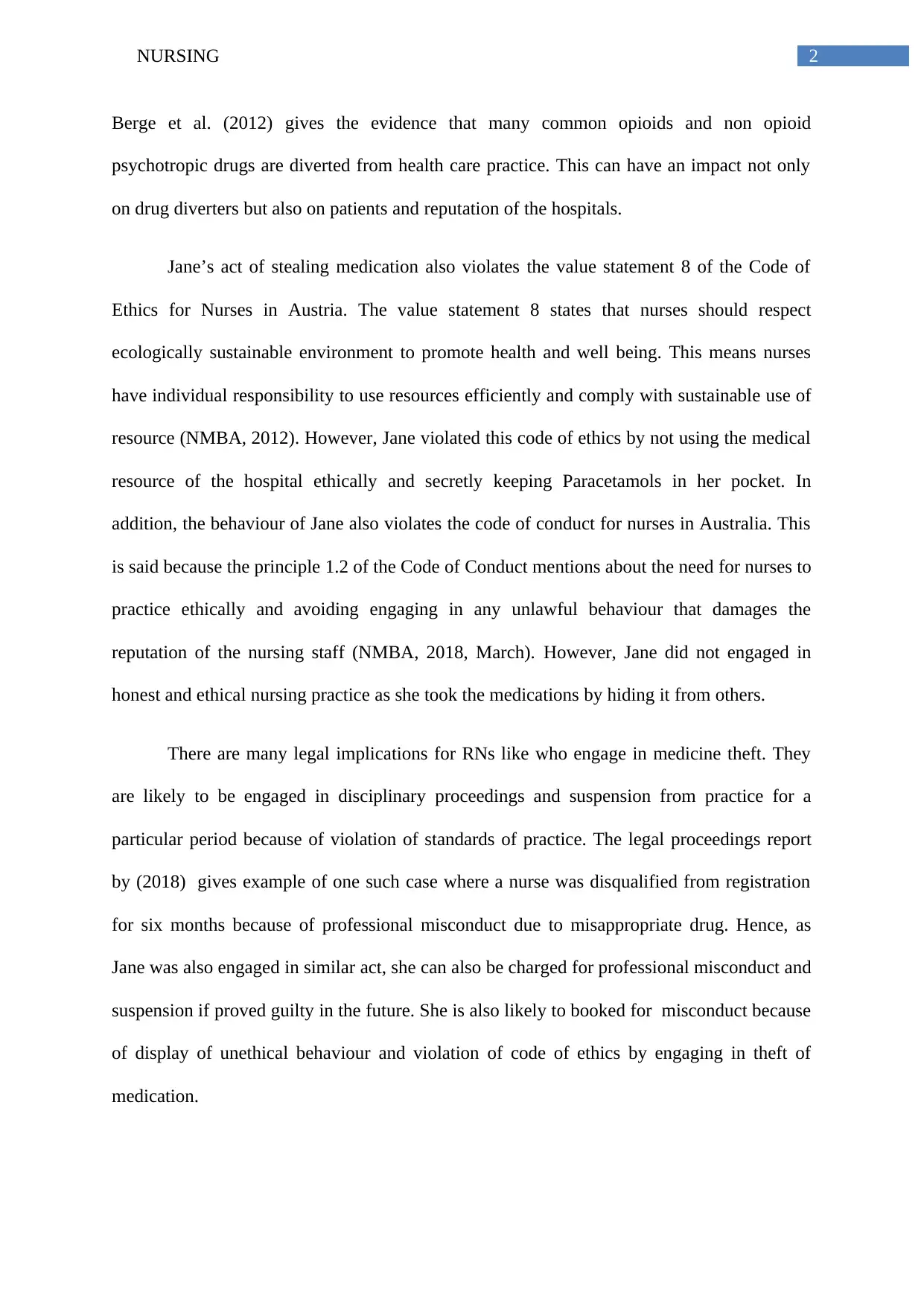
2NURSING
Berge et al. (2012) gives the evidence that many common opioids and non opioid
psychotropic drugs are diverted from health care practice. This can have an impact not only
on drug diverters but also on patients and reputation of the hospitals.
Jane’s act of stealing medication also violates the value statement 8 of the Code of
Ethics for Nurses in Austria. The value statement 8 states that nurses should respect
ecologically sustainable environment to promote health and well being. This means nurses
have individual responsibility to use resources efficiently and comply with sustainable use of
resource (NMBA, 2012). However, Jane violated this code of ethics by not using the medical
resource of the hospital ethically and secretly keeping Paracetamols in her pocket. In
addition, the behaviour of Jane also violates the code of conduct for nurses in Australia. This
is said because the principle 1.2 of the Code of Conduct mentions about the need for nurses to
practice ethically and avoiding engaging in any unlawful behaviour that damages the
reputation of the nursing staff (NMBA, 2018, March). However, Jane did not engaged in
honest and ethical nursing practice as she took the medications by hiding it from others.
There are many legal implications for RNs like who engage in medicine theft. They
are likely to be engaged in disciplinary proceedings and suspension from practice for a
particular period because of violation of standards of practice. The legal proceedings report
by (2018) gives example of one such case where a nurse was disqualified from registration
for six months because of professional misconduct due to misappropriate drug. Hence, as
Jane was also engaged in similar act, she can also be charged for professional misconduct and
suspension if proved guilty in the future. She is also likely to booked for misconduct because
of display of unethical behaviour and violation of code of ethics by engaging in theft of
medication.
Berge et al. (2012) gives the evidence that many common opioids and non opioid
psychotropic drugs are diverted from health care practice. This can have an impact not only
on drug diverters but also on patients and reputation of the hospitals.
Jane’s act of stealing medication also violates the value statement 8 of the Code of
Ethics for Nurses in Austria. The value statement 8 states that nurses should respect
ecologically sustainable environment to promote health and well being. This means nurses
have individual responsibility to use resources efficiently and comply with sustainable use of
resource (NMBA, 2012). However, Jane violated this code of ethics by not using the medical
resource of the hospital ethically and secretly keeping Paracetamols in her pocket. In
addition, the behaviour of Jane also violates the code of conduct for nurses in Australia. This
is said because the principle 1.2 of the Code of Conduct mentions about the need for nurses to
practice ethically and avoiding engaging in any unlawful behaviour that damages the
reputation of the nursing staff (NMBA, 2018, March). However, Jane did not engaged in
honest and ethical nursing practice as she took the medications by hiding it from others.
There are many legal implications for RNs like who engage in medicine theft. They
are likely to be engaged in disciplinary proceedings and suspension from practice for a
particular period because of violation of standards of practice. The legal proceedings report
by (2018) gives example of one such case where a nurse was disqualified from registration
for six months because of professional misconduct due to misappropriate drug. Hence, as
Jane was also engaged in similar act, she can also be charged for professional misconduct and
suspension if proved guilty in the future. She is also likely to booked for misconduct because
of display of unethical behaviour and violation of code of ethics by engaging in theft of
medication.
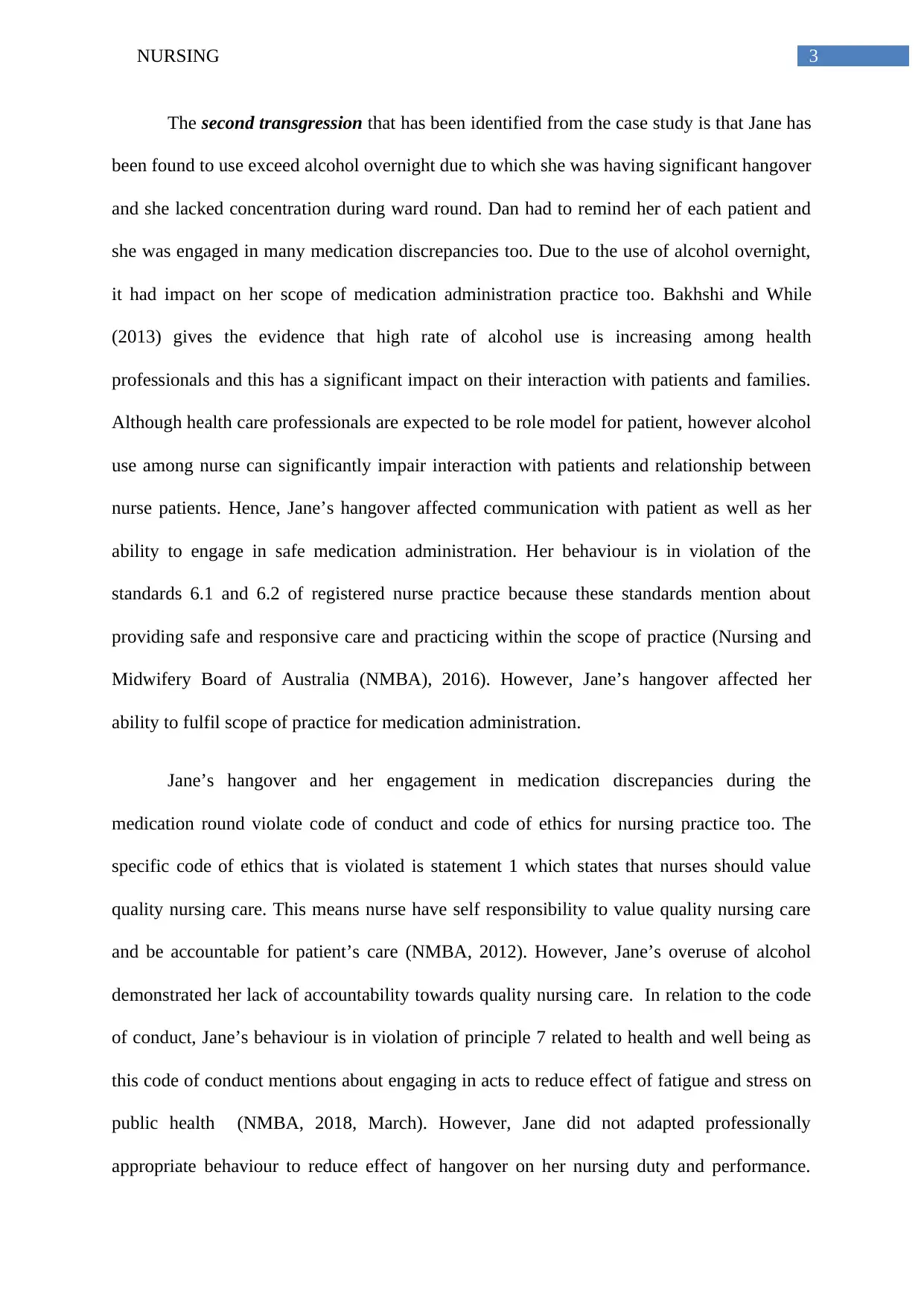
3NURSING
The second transgression that has been identified from the case study is that Jane has
been found to use exceed alcohol overnight due to which she was having significant hangover
and she lacked concentration during ward round. Dan had to remind her of each patient and
she was engaged in many medication discrepancies too. Due to the use of alcohol overnight,
it had impact on her scope of medication administration practice too. Bakhshi and While
(2013) gives the evidence that high rate of alcohol use is increasing among health
professionals and this has a significant impact on their interaction with patients and families.
Although health care professionals are expected to be role model for patient, however alcohol
use among nurse can significantly impair interaction with patients and relationship between
nurse patients. Hence, Jane’s hangover affected communication with patient as well as her
ability to engage in safe medication administration. Her behaviour is in violation of the
standards 6.1 and 6.2 of registered nurse practice because these standards mention about
providing safe and responsive care and practicing within the scope of practice (Nursing and
Midwifery Board of Australia (NMBA), 2016). However, Jane’s hangover affected her
ability to fulfil scope of practice for medication administration.
Jane’s hangover and her engagement in medication discrepancies during the
medication round violate code of conduct and code of ethics for nursing practice too. The
specific code of ethics that is violated is statement 1 which states that nurses should value
quality nursing care. This means nurse have self responsibility to value quality nursing care
and be accountable for patient’s care (NMBA, 2012). However, Jane’s overuse of alcohol
demonstrated her lack of accountability towards quality nursing care. In relation to the code
of conduct, Jane’s behaviour is in violation of principle 7 related to health and well being as
this code of conduct mentions about engaging in acts to reduce effect of fatigue and stress on
public health (NMBA, 2018, March). However, Jane did not adapted professionally
appropriate behaviour to reduce effect of hangover on her nursing duty and performance.
The second transgression that has been identified from the case study is that Jane has
been found to use exceed alcohol overnight due to which she was having significant hangover
and she lacked concentration during ward round. Dan had to remind her of each patient and
she was engaged in many medication discrepancies too. Due to the use of alcohol overnight,
it had impact on her scope of medication administration practice too. Bakhshi and While
(2013) gives the evidence that high rate of alcohol use is increasing among health
professionals and this has a significant impact on their interaction with patients and families.
Although health care professionals are expected to be role model for patient, however alcohol
use among nurse can significantly impair interaction with patients and relationship between
nurse patients. Hence, Jane’s hangover affected communication with patient as well as her
ability to engage in safe medication administration. Her behaviour is in violation of the
standards 6.1 and 6.2 of registered nurse practice because these standards mention about
providing safe and responsive care and practicing within the scope of practice (Nursing and
Midwifery Board of Australia (NMBA), 2016). However, Jane’s hangover affected her
ability to fulfil scope of practice for medication administration.
Jane’s hangover and her engagement in medication discrepancies during the
medication round violate code of conduct and code of ethics for nursing practice too. The
specific code of ethics that is violated is statement 1 which states that nurses should value
quality nursing care. This means nurse have self responsibility to value quality nursing care
and be accountable for patient’s care (NMBA, 2012). However, Jane’s overuse of alcohol
demonstrated her lack of accountability towards quality nursing care. In relation to the code
of conduct, Jane’s behaviour is in violation of principle 7 related to health and well being as
this code of conduct mentions about engaging in acts to reduce effect of fatigue and stress on
public health (NMBA, 2018, March). However, Jane did not adapted professionally
appropriate behaviour to reduce effect of hangover on her nursing duty and performance.
Secure Best Marks with AI Grader
Need help grading? Try our AI Grader for instant feedback on your assignments.
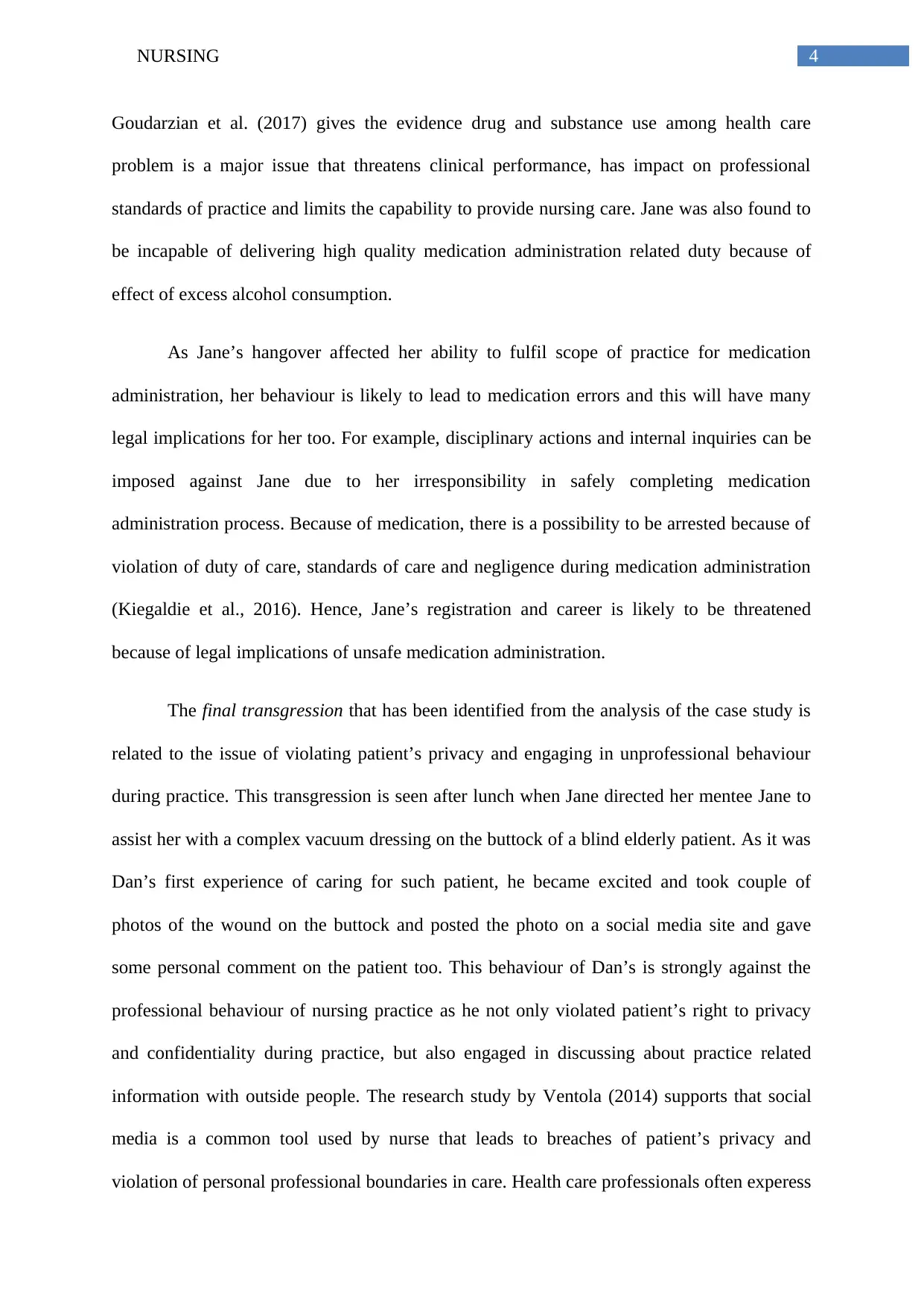
4NURSING
Goudarzian et al. (2017) gives the evidence drug and substance use among health care
problem is a major issue that threatens clinical performance, has impact on professional
standards of practice and limits the capability to provide nursing care. Jane was also found to
be incapable of delivering high quality medication administration related duty because of
effect of excess alcohol consumption.
As Jane’s hangover affected her ability to fulfil scope of practice for medication
administration, her behaviour is likely to lead to medication errors and this will have many
legal implications for her too. For example, disciplinary actions and internal inquiries can be
imposed against Jane due to her irresponsibility in safely completing medication
administration process. Because of medication, there is a possibility to be arrested because of
violation of duty of care, standards of care and negligence during medication administration
(Kiegaldie et al., 2016). Hence, Jane’s registration and career is likely to be threatened
because of legal implications of unsafe medication administration.
The final transgression that has been identified from the analysis of the case study is
related to the issue of violating patient’s privacy and engaging in unprofessional behaviour
during practice. This transgression is seen after lunch when Jane directed her mentee Jane to
assist her with a complex vacuum dressing on the buttock of a blind elderly patient. As it was
Dan’s first experience of caring for such patient, he became excited and took couple of
photos of the wound on the buttock and posted the photo on a social media site and gave
some personal comment on the patient too. This behaviour of Dan’s is strongly against the
professional behaviour of nursing practice as he not only violated patient’s right to privacy
and confidentiality during practice, but also engaged in discussing about practice related
information with outside people. The research study by Ventola (2014) supports that social
media is a common tool used by nurse that leads to breaches of patient’s privacy and
violation of personal professional boundaries in care. Health care professionals often experess
Goudarzian et al. (2017) gives the evidence drug and substance use among health care
problem is a major issue that threatens clinical performance, has impact on professional
standards of practice and limits the capability to provide nursing care. Jane was also found to
be incapable of delivering high quality medication administration related duty because of
effect of excess alcohol consumption.
As Jane’s hangover affected her ability to fulfil scope of practice for medication
administration, her behaviour is likely to lead to medication errors and this will have many
legal implications for her too. For example, disciplinary actions and internal inquiries can be
imposed against Jane due to her irresponsibility in safely completing medication
administration process. Because of medication, there is a possibility to be arrested because of
violation of duty of care, standards of care and negligence during medication administration
(Kiegaldie et al., 2016). Hence, Jane’s registration and career is likely to be threatened
because of legal implications of unsafe medication administration.
The final transgression that has been identified from the analysis of the case study is
related to the issue of violating patient’s privacy and engaging in unprofessional behaviour
during practice. This transgression is seen after lunch when Jane directed her mentee Jane to
assist her with a complex vacuum dressing on the buttock of a blind elderly patient. As it was
Dan’s first experience of caring for such patient, he became excited and took couple of
photos of the wound on the buttock and posted the photo on a social media site and gave
some personal comment on the patient too. This behaviour of Dan’s is strongly against the
professional behaviour of nursing practice as he not only violated patient’s right to privacy
and confidentiality during practice, but also engaged in discussing about practice related
information with outside people. The research study by Ventola (2014) supports that social
media is a common tool used by nurse that leads to breaches of patient’s privacy and
violation of personal professional boundaries in care. Health care professionals often experess
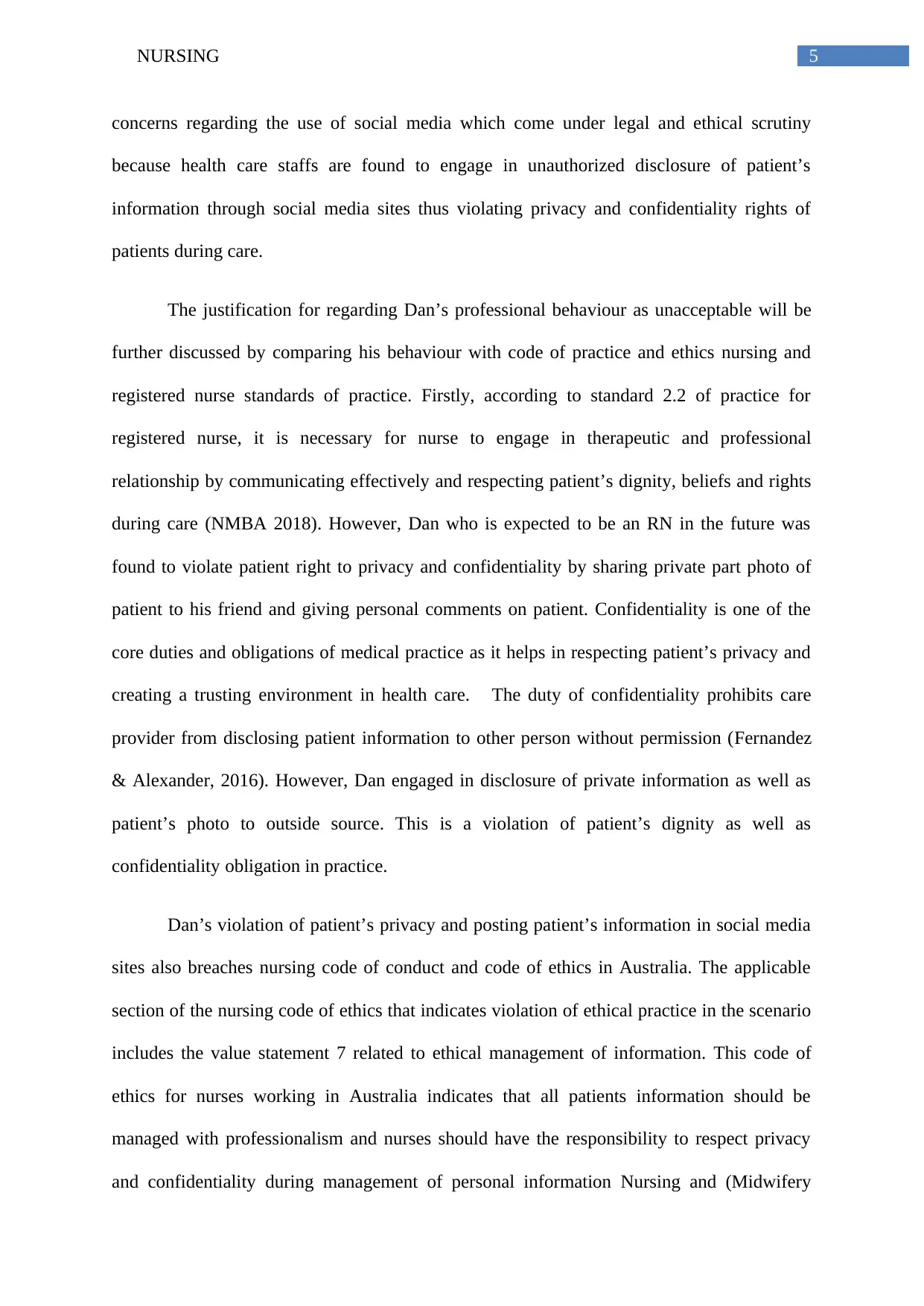
5NURSING
concerns regarding the use of social media which come under legal and ethical scrutiny
because health care staffs are found to engage in unauthorized disclosure of patient’s
information through social media sites thus violating privacy and confidentiality rights of
patients during care.
The justification for regarding Dan’s professional behaviour as unacceptable will be
further discussed by comparing his behaviour with code of practice and ethics nursing and
registered nurse standards of practice. Firstly, according to standard 2.2 of practice for
registered nurse, it is necessary for nurse to engage in therapeutic and professional
relationship by communicating effectively and respecting patient’s dignity, beliefs and rights
during care (NMBA 2018). However, Dan who is expected to be an RN in the future was
found to violate patient right to privacy and confidentiality by sharing private part photo of
patient to his friend and giving personal comments on patient. Confidentiality is one of the
core duties and obligations of medical practice as it helps in respecting patient’s privacy and
creating a trusting environment in health care. The duty of confidentiality prohibits care
provider from disclosing patient information to other person without permission (Fernandez
& Alexander, 2016). However, Dan engaged in disclosure of private information as well as
patient’s photo to outside source. This is a violation of patient’s dignity as well as
confidentiality obligation in practice.
Dan’s violation of patient’s privacy and posting patient’s information in social media
sites also breaches nursing code of conduct and code of ethics in Australia. The applicable
section of the nursing code of ethics that indicates violation of ethical practice in the scenario
includes the value statement 7 related to ethical management of information. This code of
ethics for nurses working in Australia indicates that all patients information should be
managed with professionalism and nurses should have the responsibility to respect privacy
and confidentiality during management of personal information Nursing and (Midwifery
concerns regarding the use of social media which come under legal and ethical scrutiny
because health care staffs are found to engage in unauthorized disclosure of patient’s
information through social media sites thus violating privacy and confidentiality rights of
patients during care.
The justification for regarding Dan’s professional behaviour as unacceptable will be
further discussed by comparing his behaviour with code of practice and ethics nursing and
registered nurse standards of practice. Firstly, according to standard 2.2 of practice for
registered nurse, it is necessary for nurse to engage in therapeutic and professional
relationship by communicating effectively and respecting patient’s dignity, beliefs and rights
during care (NMBA 2018). However, Dan who is expected to be an RN in the future was
found to violate patient right to privacy and confidentiality by sharing private part photo of
patient to his friend and giving personal comments on patient. Confidentiality is one of the
core duties and obligations of medical practice as it helps in respecting patient’s privacy and
creating a trusting environment in health care. The duty of confidentiality prohibits care
provider from disclosing patient information to other person without permission (Fernandez
& Alexander, 2016). However, Dan engaged in disclosure of private information as well as
patient’s photo to outside source. This is a violation of patient’s dignity as well as
confidentiality obligation in practice.
Dan’s violation of patient’s privacy and posting patient’s information in social media
sites also breaches nursing code of conduct and code of ethics in Australia. The applicable
section of the nursing code of ethics that indicates violation of ethical practice in the scenario
includes the value statement 7 related to ethical management of information. This code of
ethics for nurses working in Australia indicates that all patients information should be
managed with professionalism and nurses should have the responsibility to respect privacy
and confidentiality during management of personal information Nursing and (Midwifery
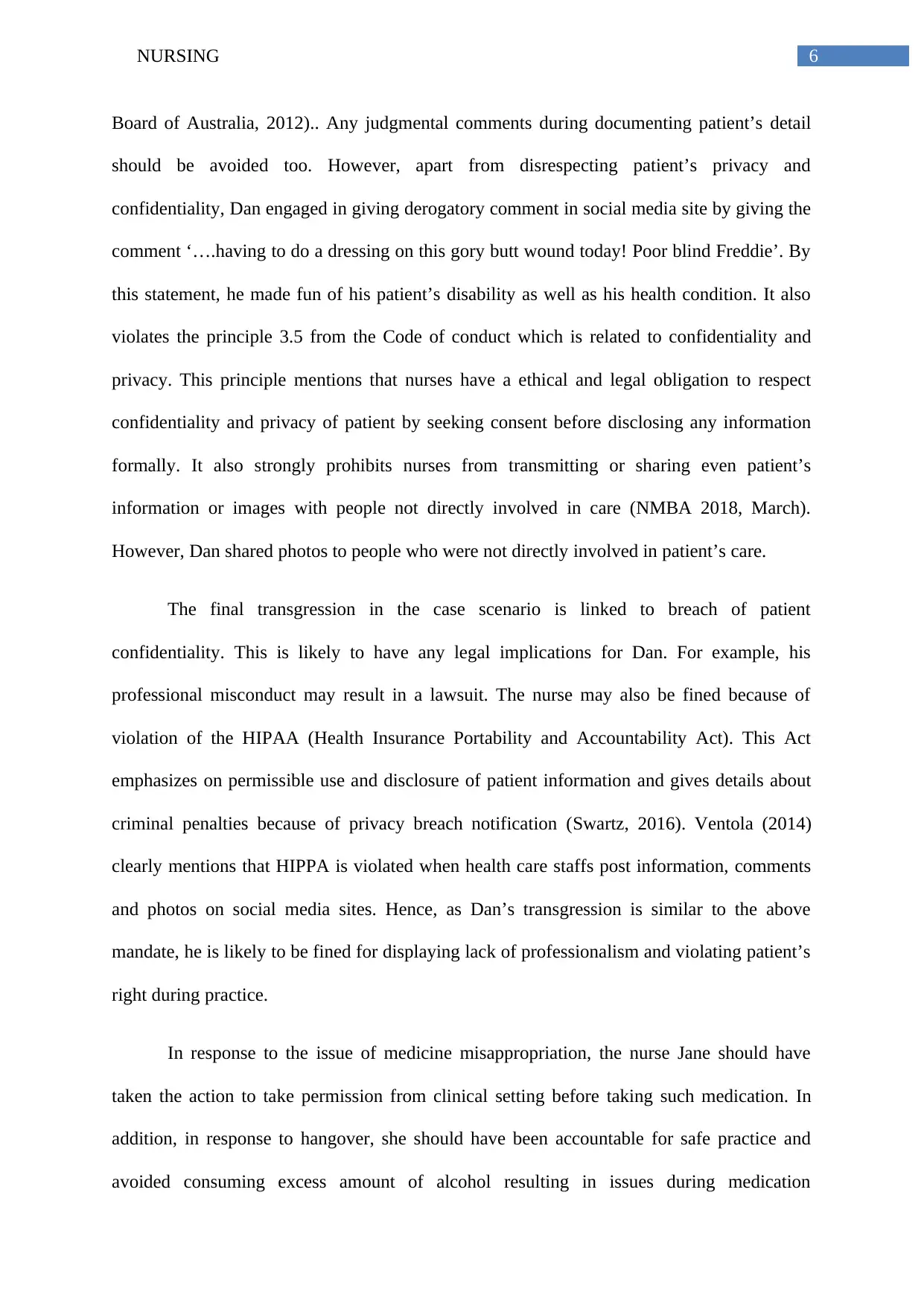
6NURSING
Board of Australia, 2012).. Any judgmental comments during documenting patient’s detail
should be avoided too. However, apart from disrespecting patient’s privacy and
confidentiality, Dan engaged in giving derogatory comment in social media site by giving the
comment ‘….having to do a dressing on this gory butt wound today! Poor blind Freddie’. By
this statement, he made fun of his patient’s disability as well as his health condition. It also
violates the principle 3.5 from the Code of conduct which is related to confidentiality and
privacy. This principle mentions that nurses have a ethical and legal obligation to respect
confidentiality and privacy of patient by seeking consent before disclosing any information
formally. It also strongly prohibits nurses from transmitting or sharing even patient’s
information or images with people not directly involved in care (NMBA 2018, March).
However, Dan shared photos to people who were not directly involved in patient’s care.
The final transgression in the case scenario is linked to breach of patient
confidentiality. This is likely to have any legal implications for Dan. For example, his
professional misconduct may result in a lawsuit. The nurse may also be fined because of
violation of the HIPAA (Health Insurance Portability and Accountability Act). This Act
emphasizes on permissible use and disclosure of patient information and gives details about
criminal penalties because of privacy breach notification (Swartz, 2016). Ventola (2014)
clearly mentions that HIPPA is violated when health care staffs post information, comments
and photos on social media sites. Hence, as Dan’s transgression is similar to the above
mandate, he is likely to be fined for displaying lack of professionalism and violating patient’s
right during practice.
In response to the issue of medicine misappropriation, the nurse Jane should have
taken the action to take permission from clinical setting before taking such medication. In
addition, in response to hangover, she should have been accountable for safe practice and
avoided consuming excess amount of alcohol resulting in issues during medication
Board of Australia, 2012).. Any judgmental comments during documenting patient’s detail
should be avoided too. However, apart from disrespecting patient’s privacy and
confidentiality, Dan engaged in giving derogatory comment in social media site by giving the
comment ‘….having to do a dressing on this gory butt wound today! Poor blind Freddie’. By
this statement, he made fun of his patient’s disability as well as his health condition. It also
violates the principle 3.5 from the Code of conduct which is related to confidentiality and
privacy. This principle mentions that nurses have a ethical and legal obligation to respect
confidentiality and privacy of patient by seeking consent before disclosing any information
formally. It also strongly prohibits nurses from transmitting or sharing even patient’s
information or images with people not directly involved in care (NMBA 2018, March).
However, Dan shared photos to people who were not directly involved in patient’s care.
The final transgression in the case scenario is linked to breach of patient
confidentiality. This is likely to have any legal implications for Dan. For example, his
professional misconduct may result in a lawsuit. The nurse may also be fined because of
violation of the HIPAA (Health Insurance Portability and Accountability Act). This Act
emphasizes on permissible use and disclosure of patient information and gives details about
criminal penalties because of privacy breach notification (Swartz, 2016). Ventola (2014)
clearly mentions that HIPPA is violated when health care staffs post information, comments
and photos on social media sites. Hence, as Dan’s transgression is similar to the above
mandate, he is likely to be fined for displaying lack of professionalism and violating patient’s
right during practice.
In response to the issue of medicine misappropriation, the nurse Jane should have
taken the action to take permission from clinical setting before taking such medication. In
addition, in response to hangover, she should have been accountable for safe practice and
avoided consuming excess amount of alcohol resulting in issues during medication
Paraphrase This Document
Need a fresh take? Get an instant paraphrase of this document with our AI Paraphraser
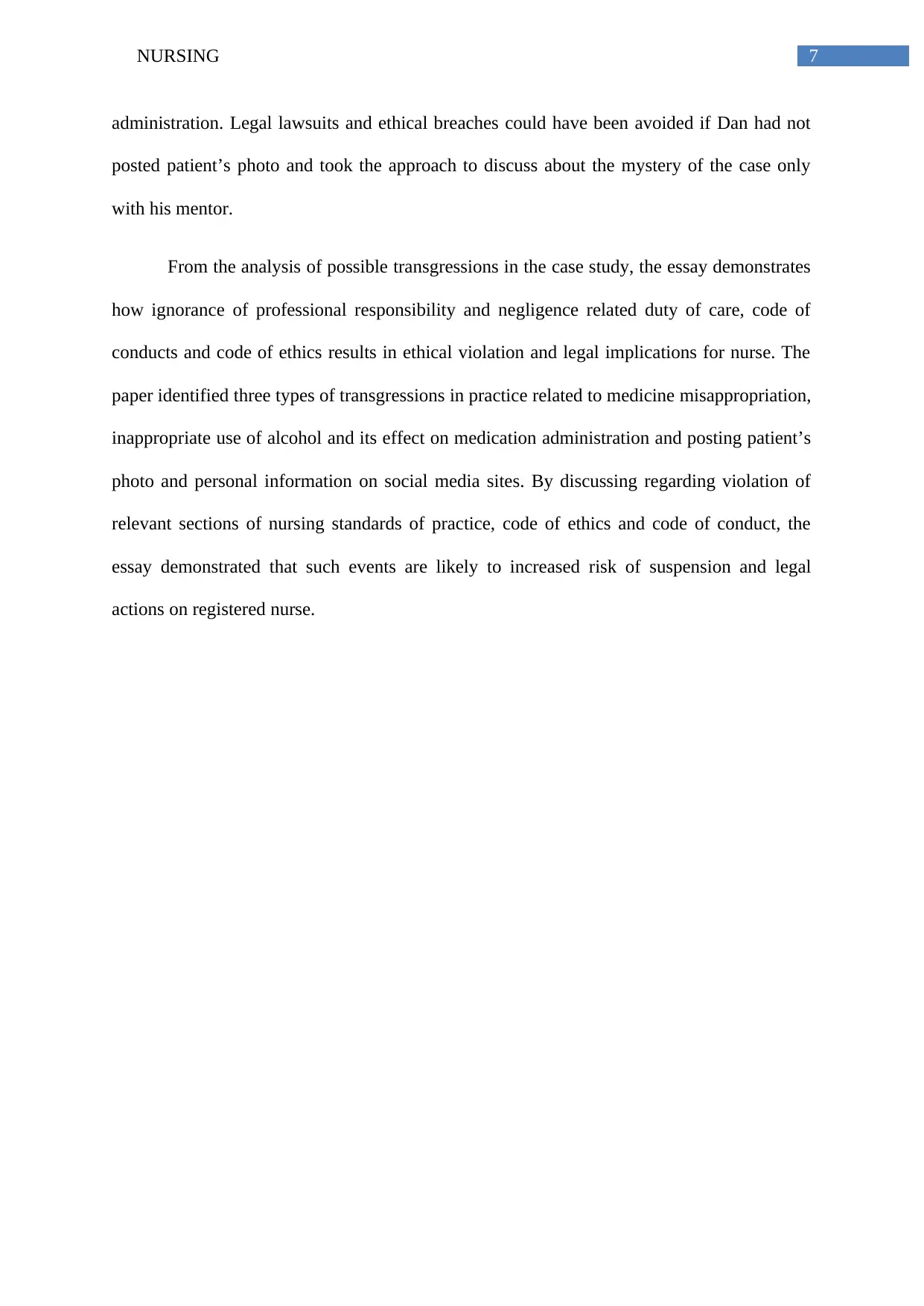
7NURSING
administration. Legal lawsuits and ethical breaches could have been avoided if Dan had not
posted patient’s photo and took the approach to discuss about the mystery of the case only
with his mentor.
From the analysis of possible transgressions in the case study, the essay demonstrates
how ignorance of professional responsibility and negligence related duty of care, code of
conducts and code of ethics results in ethical violation and legal implications for nurse. The
paper identified three types of transgressions in practice related to medicine misappropriation,
inappropriate use of alcohol and its effect on medication administration and posting patient’s
photo and personal information on social media sites. By discussing regarding violation of
relevant sections of nursing standards of practice, code of ethics and code of conduct, the
essay demonstrated that such events are likely to increased risk of suspension and legal
actions on registered nurse.
administration. Legal lawsuits and ethical breaches could have been avoided if Dan had not
posted patient’s photo and took the approach to discuss about the mystery of the case only
with his mentor.
From the analysis of possible transgressions in the case study, the essay demonstrates
how ignorance of professional responsibility and negligence related duty of care, code of
conducts and code of ethics results in ethical violation and legal implications for nurse. The
paper identified three types of transgressions in practice related to medicine misappropriation,
inappropriate use of alcohol and its effect on medication administration and posting patient’s
photo and personal information on social media sites. By discussing regarding violation of
relevant sections of nursing standards of practice, code of ethics and code of conduct, the
essay demonstrated that such events are likely to increased risk of suspension and legal
actions on registered nurse.
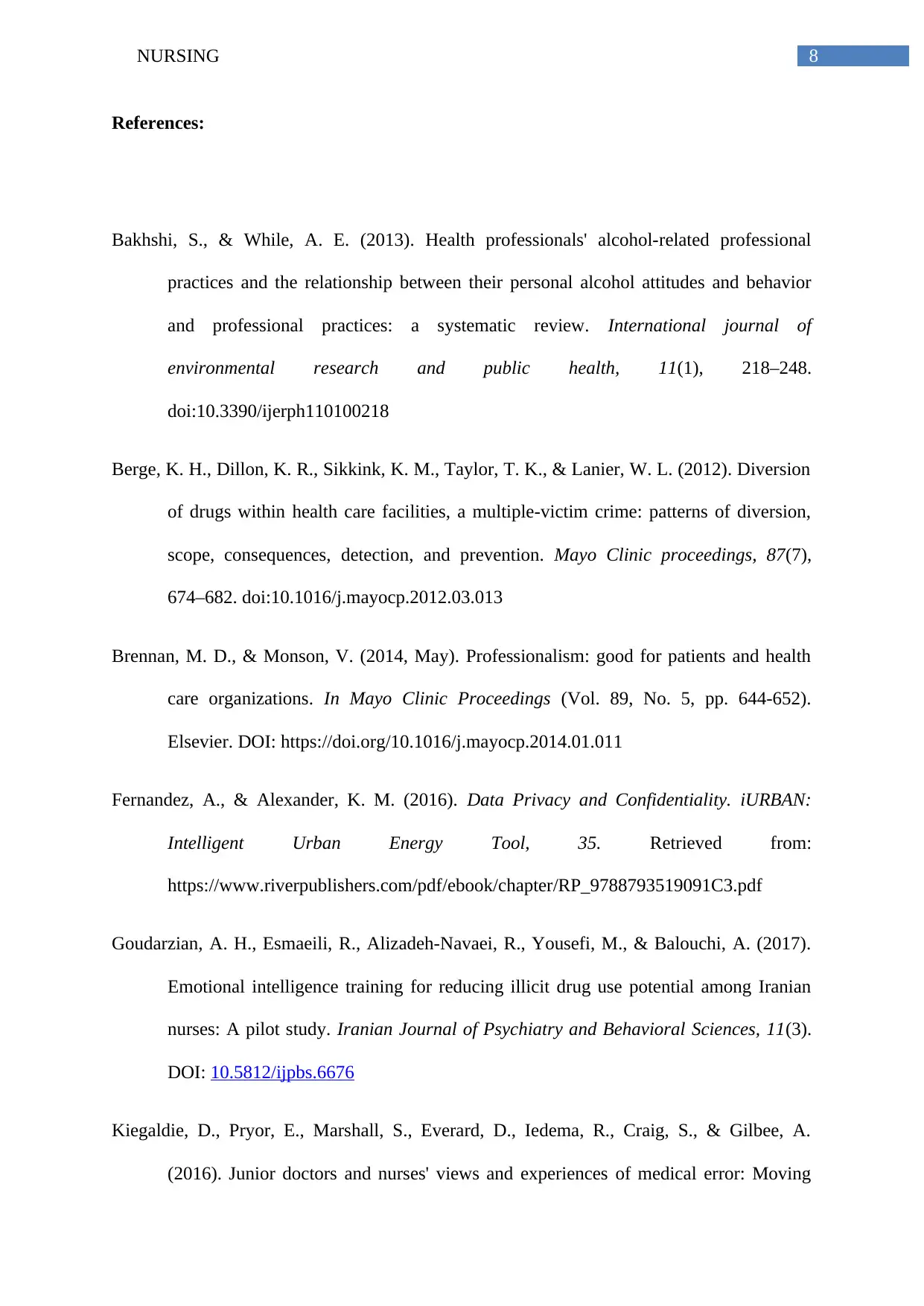
8NURSING
References:
Bakhshi, S., & While, A. E. (2013). Health professionals' alcohol-related professional
practices and the relationship between their personal alcohol attitudes and behavior
and professional practices: a systematic review. International journal of
environmental research and public health, 11(1), 218–248.
doi:10.3390/ijerph110100218
Berge, K. H., Dillon, K. R., Sikkink, K. M., Taylor, T. K., & Lanier, W. L. (2012). Diversion
of drugs within health care facilities, a multiple-victim crime: patterns of diversion,
scope, consequences, detection, and prevention. Mayo Clinic proceedings, 87(7),
674–682. doi:10.1016/j.mayocp.2012.03.013
Brennan, M. D., & Monson, V. (2014, May). Professionalism: good for patients and health
care organizations. In Mayo Clinic Proceedings (Vol. 89, No. 5, pp. 644-652).
Elsevier. DOI: https://doi.org/10.1016/j.mayocp.2014.01.011
Fernandez, A., & Alexander, K. M. (2016). Data Privacy and Confidentiality. iURBAN:
Intelligent Urban Energy Tool, 35. Retrieved from:
https://www.riverpublishers.com/pdf/ebook/chapter/RP_9788793519091C3.pdf
Goudarzian, A. H., Esmaeili, R., Alizadeh-Navaei, R., Yousefi, M., & Balouchi, A. (2017).
Emotional intelligence training for reducing illicit drug use potential among Iranian
nurses: A pilot study. Iranian Journal of Psychiatry and Behavioral Sciences, 11(3).
DOI: 10.5812/ijpbs.6676
Kiegaldie, D., Pryor, E., Marshall, S., Everard, D., Iedema, R., Craig, S., & Gilbee, A.
(2016). Junior doctors and nurses' views and experiences of medical error: Moving
References:
Bakhshi, S., & While, A. E. (2013). Health professionals' alcohol-related professional
practices and the relationship between their personal alcohol attitudes and behavior
and professional practices: a systematic review. International journal of
environmental research and public health, 11(1), 218–248.
doi:10.3390/ijerph110100218
Berge, K. H., Dillon, K. R., Sikkink, K. M., Taylor, T. K., & Lanier, W. L. (2012). Diversion
of drugs within health care facilities, a multiple-victim crime: patterns of diversion,
scope, consequences, detection, and prevention. Mayo Clinic proceedings, 87(7),
674–682. doi:10.1016/j.mayocp.2012.03.013
Brennan, M. D., & Monson, V. (2014, May). Professionalism: good for patients and health
care organizations. In Mayo Clinic Proceedings (Vol. 89, No. 5, pp. 644-652).
Elsevier. DOI: https://doi.org/10.1016/j.mayocp.2014.01.011
Fernandez, A., & Alexander, K. M. (2016). Data Privacy and Confidentiality. iURBAN:
Intelligent Urban Energy Tool, 35. Retrieved from:
https://www.riverpublishers.com/pdf/ebook/chapter/RP_9788793519091C3.pdf
Goudarzian, A. H., Esmaeili, R., Alizadeh-Navaei, R., Yousefi, M., & Balouchi, A. (2017).
Emotional intelligence training for reducing illicit drug use potential among Iranian
nurses: A pilot study. Iranian Journal of Psychiatry and Behavioral Sciences, 11(3).
DOI: 10.5812/ijpbs.6676
Kiegaldie, D., Pryor, E., Marshall, S., Everard, D., Iedema, R., Craig, S., & Gilbee, A.
(2016). Junior doctors and nurses' views and experiences of medical error: Moving
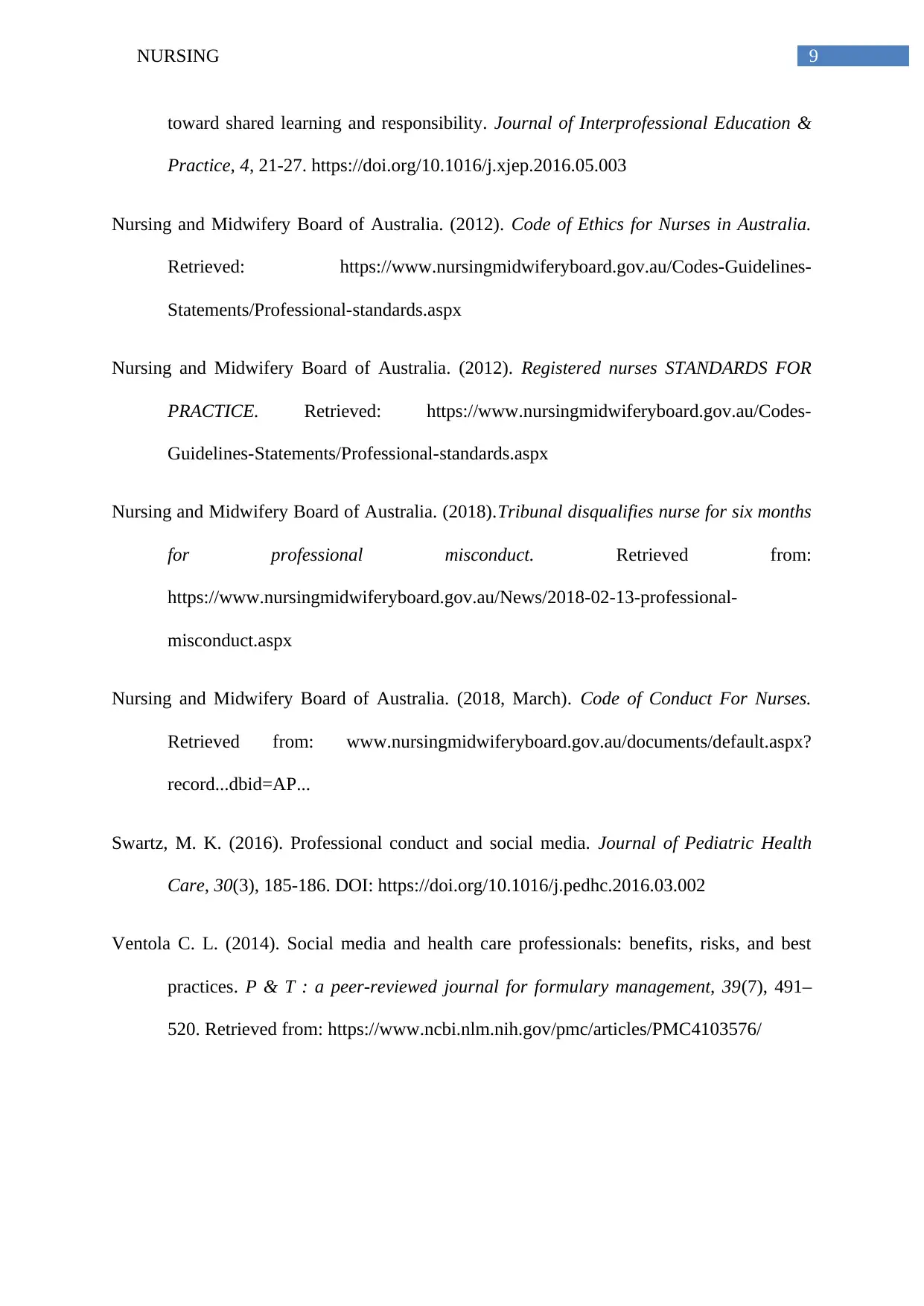
9NURSING
toward shared learning and responsibility. Journal of Interprofessional Education &
Practice, 4, 21-27. https://doi.org/10.1016/j.xjep.2016.05.003
Nursing and Midwifery Board of Australia. (2012). Code of Ethics for Nurses in Australia.
Retrieved: https://www.nursingmidwiferyboard.gov.au/Codes-Guidelines-
Statements/Professional-standards.aspx
Nursing and Midwifery Board of Australia. (2012). Registered nurses STANDARDS FOR
PRACTICE. Retrieved: https://www.nursingmidwiferyboard.gov.au/Codes-
Guidelines-Statements/Professional-standards.aspx
Nursing and Midwifery Board of Australia. (2018).Tribunal disqualifies nurse for six months
for professional misconduct. Retrieved from:
https://www.nursingmidwiferyboard.gov.au/News/2018-02-13-professional-
misconduct.aspx
Nursing and Midwifery Board of Australia. (2018, March). Code of Conduct For Nurses.
Retrieved from: www.nursingmidwiferyboard.gov.au/documents/default.aspx?
record...dbid=AP...
Swartz, M. K. (2016). Professional conduct and social media. Journal of Pediatric Health
Care, 30(3), 185-186. DOI: https://doi.org/10.1016/j.pedhc.2016.03.002
Ventola C. L. (2014). Social media and health care professionals: benefits, risks, and best
practices. P & T : a peer-reviewed journal for formulary management, 39(7), 491–
520. Retrieved from: https://www.ncbi.nlm.nih.gov/pmc/articles/PMC4103576/
toward shared learning and responsibility. Journal of Interprofessional Education &
Practice, 4, 21-27. https://doi.org/10.1016/j.xjep.2016.05.003
Nursing and Midwifery Board of Australia. (2012). Code of Ethics for Nurses in Australia.
Retrieved: https://www.nursingmidwiferyboard.gov.au/Codes-Guidelines-
Statements/Professional-standards.aspx
Nursing and Midwifery Board of Australia. (2012). Registered nurses STANDARDS FOR
PRACTICE. Retrieved: https://www.nursingmidwiferyboard.gov.au/Codes-
Guidelines-Statements/Professional-standards.aspx
Nursing and Midwifery Board of Australia. (2018).Tribunal disqualifies nurse for six months
for professional misconduct. Retrieved from:
https://www.nursingmidwiferyboard.gov.au/News/2018-02-13-professional-
misconduct.aspx
Nursing and Midwifery Board of Australia. (2018, March). Code of Conduct For Nurses.
Retrieved from: www.nursingmidwiferyboard.gov.au/documents/default.aspx?
record...dbid=AP...
Swartz, M. K. (2016). Professional conduct and social media. Journal of Pediatric Health
Care, 30(3), 185-186. DOI: https://doi.org/10.1016/j.pedhc.2016.03.002
Ventola C. L. (2014). Social media and health care professionals: benefits, risks, and best
practices. P & T : a peer-reviewed journal for formulary management, 39(7), 491–
520. Retrieved from: https://www.ncbi.nlm.nih.gov/pmc/articles/PMC4103576/
1 out of 10
Related Documents
Your All-in-One AI-Powered Toolkit for Academic Success.
+13062052269
info@desklib.com
Available 24*7 on WhatsApp / Email
![[object Object]](/_next/static/media/star-bottom.7253800d.svg)
Unlock your academic potential
© 2024 | Zucol Services PVT LTD | All rights reserved.





